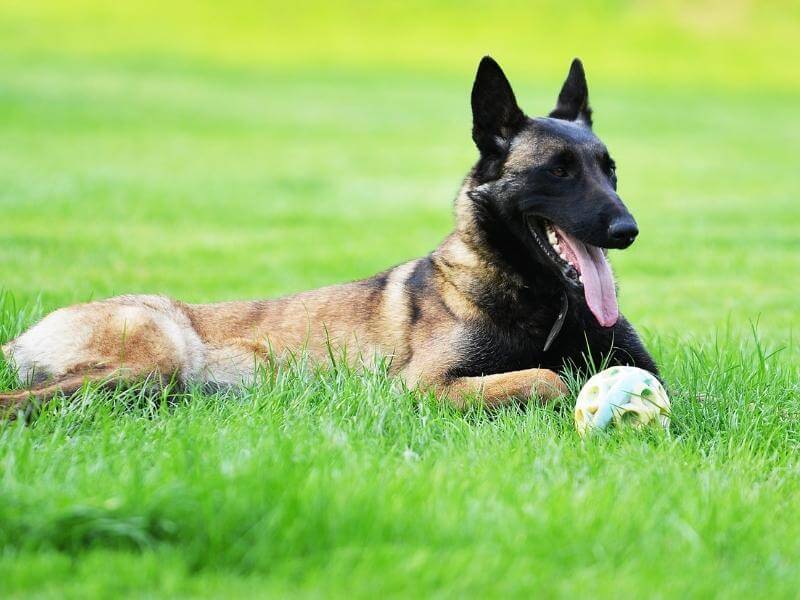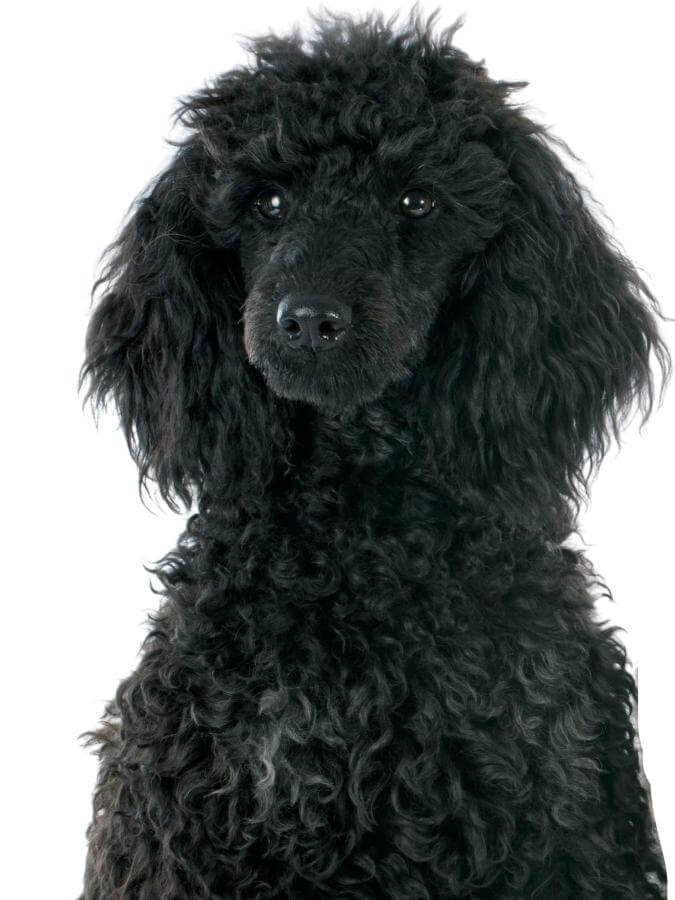What do you get when you cross a Belgian Malinois with a Poodle? The Malinoodle!
This unique Doodle dog is athletic, friendly, and easy to train. They are medium-to-large in size and have a range of different coat colors.
Is a Malinoodle the perfect dog for you? Find out below!
What is a Malinoodle?
A Malinoodle is a mix between a Belgian Malinois and a Poodle.
They are also called Belgian Malinoodles, Maldoodles, Malidoodles, or Malinois Doodles.
The Belgian Malinoodle is a ball of energy that would make a great competitor, an exciting athletic companion, or an excellent addition to an active family.
They are not too much for cuddles but are very smart, loyal, and attentive to your needs. As a companion, Belgian Malindoodles are strong, adaptable, and comfortable in social settings as long the dog is trained well.
Check out my Malinoodle video
Don’t feel like reading about the Malinoodle? Check out my video of the Belgian Malinois-Poodle mix.
History of the Parent Breeds
The Belgian Malinoodle is a mix without an official history, although they have been around for a fair amount of time.
Since there is a large amount of history and reputation between the two parent breeds of the Belgian Malinois and the Poodle, we will explore their background. Understanding their background will help you estimate their inherited traits, personality, and requirements.
Belgian Malinois

The Belgian Malinois is one of the four Belgian Sheepdogs. The first record of these dogs, as well as the other three, is around 1800. Although the Tervuren, Laekenois, and Belgian Shepherd, are under the same Umbrella, the Malinois has very distinct personality traits.
Before the turn of the century, Belgian Malinois were all-around farm dogs who excelled at any task but were known for herding livestock. Any job they did quickly became second nature, and people loved their mental sharpness, work stamina, and large memory bank for training.
Although not certified as an official breed until 1959, the Malinois has been in America in 1911. They worked as farm dogs for a while, but their intelligence and hard work ethic graduated them to other careers and activities.
As farms became more commercialized, the Belgian Malinois rose to protect their owners and country. In honor of their legacy, there is a statue of a Belgian Malinois alongside the WWI Troop Memorial in Fayetteville, NC. In the trenches, they served not only as police dogs but also as messenger carriers, ambulance dogs, and machine gun pullers.
Modern Day Popularity
Besides German Shepherds, Malinois are the most popular breed for police and military K-9s. Their physical resistance, intelligence, passion, and nearly unmatched abilities make them the perfect candidates for those occupations.
The Belgian Malinois has established a good reputation for conformation training, obedience training, search and rescue, and IPO protection training.

Most people who buy Malinois want to train them for competition. The main competitions are usually French Ring, Agility, and Schitzon.
For regular dog owners, Malinois excel in activities and sports such as herding, sledding, running, and therapy. If you are energetic and have an active lifestyle, they will be the perfect partner to go on 5-mile runs or bike rides with you in the morning.
Poodle

Contrary to the name “French Poodle,” their first documentation was actually in Germany. Originally, they were duck hunters whose swimming ability, intelligence, and energy made them a sought-after breed.
Poodles slowly migrated from the hunting grounds to people’s homes. Many Europeans, especially the French, took a liking to Poodles and the breed began to spread across the continent.
Poodles remained as hunting companions, but they were also dispersed into other areas, such as the circus and French nobles’ sides.
The breed was selectively bred to produce a smaller dog for easy transportation and handling. The smaller version was named the Miniature Poodle.

In America, Mini Poodles were bred down even more to create the Toy Poodle. The smaller size was perfect for city-dwellers who couldn’t accommodate a medium or standard-sized Poodle.
The popularity of the Poodle
No matter the size, Poodles are a staple breed across the world. A hypoallergenic coat paired with excellent qualities makes them highly sought after by many households. This is also the reason behind the surge of Poodle mixes, or Doodles, in recent years.
Appearance
The Belgian Malinois is a robust, well-muscled dog with short, smooth fur. They have bright eyes, black ears, and a mask the color of Belgian chocolate.
The Standard Poodle is a medium-sized dog. They have long, lean, athletic bodies. We will cover their specific colors later in the article.
The Belgian Malinoodle is a dog with solid muscles and speed. They can function well in an active home, training competition, or law enforcement opportunity.
Coat Type
The Belgian Malinois has a minimal-effort, short, waterproof fur coat. Brushing them with a medium-bristle brush occasionally is enough to keep them looking good. They only shed twice a year.
Poodles have hair and not fur. This means that although they do not shed, their hair will keep growing and can matt together. They require brushing daily or every other day.
Belgian Malinoodles could come out with a mix or one instead of the other. From an early age, be proactive and set a brushing routine of grooming every other day with a quality brush. Trim them as you wish, but follow the rule of “thinner in summer and denser in the winter.”
Coat Colors
The Belgian Malinois fur color ranges from deep fawn to mahogany. Their ears are black, and their masks are a Belgian chocolate color, as mentioned above. Poodles, on the other hand, come in a variety of colors.
Combining both parent breed’s color profiles, the Belgian Malinoodles can take on the following coat colors:
- Apricot
- Biscuit
- Black
- Blue
- Blue Fawn
- Brindle
- Brown (or Chocolate)
- Café-au-lait
- Cream
- Fawn
- Gray
- Liver
- Red
- Red Fawn
- Silver
- White
- Yellow
Malinoodles can be mono-colored or a combination of the ones listed above. They can have unique coat patterns such as parti, merle, phantom, tuxedo, and tri-color.
Size
The size of your Malinoodle will depend on the parents of the litter. They are by no means a small dog, unless the Malinois is bred with a smaller-sized Poodle.
The sire, or father, of the litter could be a Belgian Malinois or could be a Poodle. The same is true for the dam, or mother. This will have an effect on the overall size of the dogs since both parent breeds have different genetics.
Height
If you combine the Belgian Malinois with the Standard Poodle, you will get a lean medium-sized dog in most cases.
Belgian Malinoodles will range between 15-24 inches from the ground to the shoulder. You should take the size of the sire (father) dog as a reference for how tall the puppy will grow.
Weight
Belgian Malinoodles weigh about 40-80 pounds.
The average weight range for Poodles, by type, are:
- Standard are usually 40 to 70 pounds
- Miniature are 10 to 15 pounds
- Toy are 4 to 6 pounds
Compared to a Standard Poodle, the Belgian Malinois is a little smaller and sits between 55-65 pounds for males and 49-55 pounds for females.
If the father of the litter is a Standard Poodle, then the dogs will likely be much heavier and taller than if a Miniature Poodle was the sire.
Traits & Characteristics

Malinoodle Personality
Both parent breeds have an endless memory, a love of effortless movement, and inexhaustible energy.
They are naturally alert and responsive to their owners and are very versatile in their activities because of their high intelligence.
Like their Poodle ancestors, they are great companions for running, hiking, and exploring. They are calm as long as they get their exercise for the day.
Belgian Malinoodles are good with children and affectionate but cannot snuggle up on the couch all day long.
Belgian Malinoodles are friendly with strangers but will be standoffish until the person has regular appearances around the dog. Even though these dogs have super high energy, owners say they don’t bark much and barely growl.
Both their parent breeds require regular mental stimulation by going outside often or having a lot of toys to challenge them.
Belgian Malinoodles are good with young children and can make great family dogs as long as they are trained and have a disciplined owner. You can take this breed to dog parks, but test the dog’s personality before allowing them to play with other dogs.
Common Health Issues
The Belgian Malinoodle is a relatively healthy dog that doesn’t suffer from health issues as long as they are physically active. Although not likely, this breed is predisposed to hip and elbow dysplasia and certain eye disorders in old age.
They should get semi-regular hip, elbow, and ophthalmologist evaluations, so nothing slips through the cracks. Be sure to check their ears often to protect them from infection.
Lifespan
The average lifetime of a Malinoodle is 10-16 years.
Final Thoughts
The Belgian Malinoodle is an excellent companion for anyone with an active lifestyle! Whether it be law enforcement, competition, or exploring nature, this dog will be entirely in sync with you.
Their high intelligence, versatility, and energetic personality will make them the perfect lifelong friends and partners in crime.


